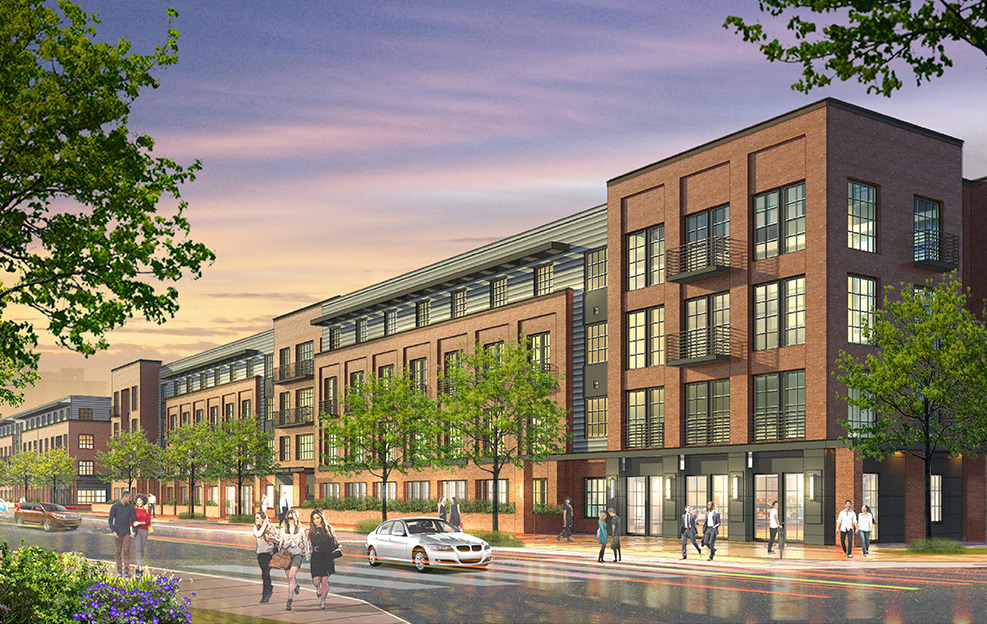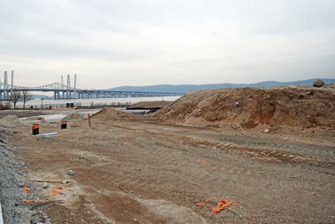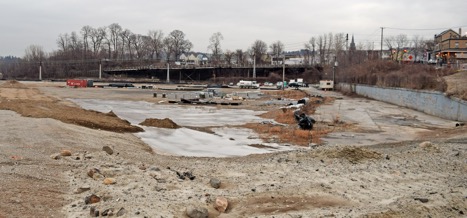January 18, 2018 | By Aleesia Forni | Westfair Online
News in Detail
Delayed Sleepy Hollow development Edge-on-Hudson moves toward home construction

A rendering of the project on the Hudson River in Sleepy Hollow.
After nearly two decades of delays and a yearlong infrastructure buildout, vertical construction could soon begin at Edge-on-Hudson, the 67-acre mixed-use development on the site of the former General Motors assembly plant in Sleepy Hollow.
The estimated $1 billion waterfront project off Beekman Avenue, which broke ground in May 2016, is a joint venture between SunCal, a California developer of residential and commercial properties, and Diversified Realty Advisors, a developer in Montville, New Jersey.
“2017 was the year that kind of observable progress was really made,” said Peter Chavkin, lead development consultant with SunCal.
Most of the year, he said, was spent installing the infrastructure that would support the first phase of development, including importing dirt to raise the site and constructing a roadway and roundabout on the property.

The development is just north of the Tappan Zee Bridge. Photo by Aleesia Forni
The joint venture announced earlier this month that Toll Brothers, a 50-year-old Fortune 500 company based in Pennsylvania, signed an agreement to purchase and build out lots as part of the project’s first phase. Development on the 24-acre western parcel of the site will include as many as 306 units of housing, including 61 units of affordable, senior and workforce housing.
Chavkin declined to disclose the price Toll Brothers paid for the parcel, but said the company is “the perfect homebuilder for this project. Once they get that process going, to begin seeing buildings come up is going to be an exciting thing for us and for the community.”
Ultimately, the sprawling Edge-on-Hudson project is expected to include 1,177 units of condominiums, townhouses and rental apartments; a 140-room boutique hotel; 135,000 square feet of retail space and 35,000 square feet of office space. The development will also feature more than 16 acres of parkland and a promenade along the water, linking the existing Riverwalk to the south and Kingsland Point Park to the north.
Chavkin said the joint venture continues to weigh its options for the next steps of the property’s development.
“We’re finalizing at this point a couple of different directions we could go. I’d like to see phase two include some waterfront units, but we haven’t finalized anything,” Chavkin said. “As soon as we get Toll Brothers closed on phase one, we’d expect to turn our attention to phase two and future phases.”
Barring any holdups or unexpected delays, Chavkin said Toll Brothers could begin vertical construction on the project later this year.
After a years-long journey, Diversified Realty founding partner Jonathan Stein said, “I’m thrilled to see this project reach fruition.”

A view of the project looking north. Photo by Aleesia Forni
Stein has been involved with the project since 1998, the year he was approached by GM officials regarding the development of the site. Stein was at the time a partner at Roseland Property Co., the New Jersey company that was later chosen to redevelop the property in 2001.
The project was delayed for several years by lawsuits brought against Sleepy Hollow by both the neighboring village of Tarrytown and GM. The recession and GM’s bankruptcy reorganization also held up the development’s progress. Roseland and General Motors parted ways on the project in 2007.
In 2012, General Motors issued another request for proposals from developers and reached out to Stein at his new company, Diversified Realty, to see if he would be interested in participating.
The automaker then completed an environmental cleanup of the industrially contaminated site in 2013. The following year, the joint venture of Diversified Realty and SunCal purchased the site for $39.5 million.
Chavkin, who has been involved with the project since 2012, said that despite all the delays the project has seen, “We think the market continues to be really strong for the product we’re expecting to deliver.”
The transit-oriented development, which is less than a mile from both the Philipse Manor and Tarrytown Metro-North stations, will likely attract residents who may have been priced out of New York City, Chavkin said, and will offer the mix of suburban and urban living that many renters and homebuyers are looking for.
“In the past, a luxury development meant something that was exclusive, and I don’t think that’s what today’s luxury buyer wants,” Chavkin said. “I think the idea that we’re going to have renters and homeowners in the same place, along with public parks and waterfront all in the same community, is really compelling to today’s luxury buyer.”
